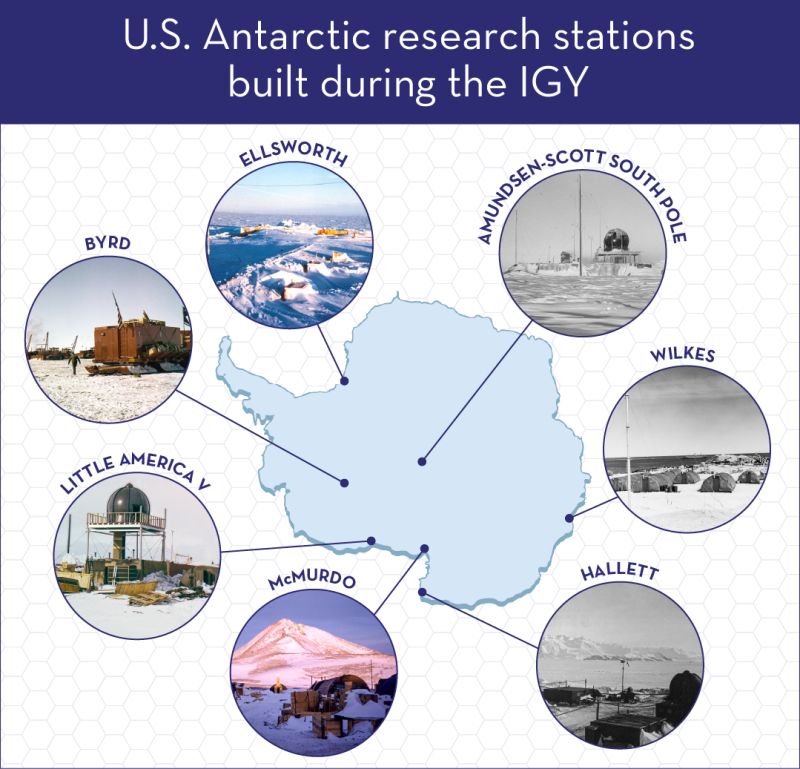Celebrating the 65th anniversary of the International Geophysical Year
The ‘Year of Discovery’ set the precedent for international scientific cooperation
2022 is the 65th anniversary of the International Geophysical Year, or IGY, a collaborative, worldwide effort among 60 countries, 10,000 scientists and multiple scientific fields to study the Earth and sun. Today we celebrate the amazing contributions made possible by one of the most successful international scientific efforts in history.
An 18-month-long effort, the IGY took place from July 1, 1957, to Dec. 31, 1958. It launched a new era of scientific discovery that has fundamentally changed the way researchers understand the planet.
Coinciding with the peak of the 11-year solar cycle where the sun’s magnetic field flips, the IGY was timed so scientists could study sunspots and observe the sun’s corona during a solar eclipse. Scientists designed and built instruments to study the atmosphere and near space environment, deployed seismic equipment to study earthquakes and ice sheets and used newly constructed radio and astronomical observatories to observe the sun and stars. For their research, scientists adapted many technologies first developed during World War II.
The U.S. National Science Foundation, which had been established just seven years earlier, was instrumental in supporting and coordinating IGY research by U.S. scientists. NSF began planning for the IGY and issuing grants to researchers in 1955, a massive undertaking that required building infrastructure to house and support scientists in some the most remote and harsh environments on the planet.
Major findings from the IGY
Scientists collected geophysical data all over the world and made groundbreaking discoveries during the IGY. A joint British-American survey of the Atlantic Ocean from September 1954 to July 1959 defined the full length of the Mid-Atlantic Ridge, the underwater mountain range where new seafloor forms as Earth’s tectonic plates are pulled apart. This major discovery led to the mapping of the global mid-ocean ridge system and provided crucial confirmation of plate tectonic theory.
The space race is also connected to the IGY. The U.S. revealed publicly in 1955 that it would launch a satellite program as part of the IGY. But the Soviet Union launched the first artificial satellite, Sputnik 1, in October 1957. The U.S. launched its first satellites just a few months later in January 1958.
Instruments on the American satellites detected massive rings of charged particles trapped by Earth’s magnetic field more than 400 miles above the planet’s surface. They were named the Van Allen radiation belts after the scientist who discovered them, and they help shield Earth (and its inhabitants) from harmful high-energy particles traveling through space.
U.S. Antarctic Program
Conducting research in Antarctica was a major focus of the IGY. Antarctica was the least-studied continent at the time and remains one of the best places to collect data on space weather and Earth’s upper atmosphere. The U.S. built seven Antarctic research stations in preparation for the IGY, two of which are still in operation today. In August 1958, the U.S. established what would later be named the U.S. Antarctic Program to oversee U.S. scientific research on the continent.
The IGY allowed scientists to study the Antarctic ice sheet in greater detail. Only small expeditions explored Antarctica before the IGY and most stayed near the coastline, so it wasn’t possible to study the interior of the continent or its massive ice sheets on a large scale.
But during the IGY, scientists took their first deep dive into Antarctica’s interior. Meteorologists measured the lowest air temperature ever recorded at the South Pole: minus 102 degrees Fahrenheit on September 17, 1957. That record has since been broken but was a major discovery at the time.
In addition, glaciologists got their first chance to study Antarctic ice in detail. American scientists studied the ice sheet from several of the U.S. research stations, on overland traverses across the continent, and from aircraft. They found the West Antarctic Ice Sheet was on average over 6,000 feet thick and that, unexpectedly, much of the ground surface under the ice was far below sea level.
Researchers dug deep snow pits at Wilkes Station to study the physical properties of the ice. Researchers drilled ice cores at Little America V and Byrd Station, paving the way for ice core research that has become an integral part of Antarctic science in the decades since. Ice cores have allowed scientists to reconstruct Earth’s climate in the far past, providing proof of human-caused climate change that has taken place since the Industrial Revolution began.
Antarctic research during the IGY was so fruitful that the U.S. and 11 other countries decided to continue supporting research on the southernmost continent. Their efforts during the IGY led to the Antarctic Treaty, one of the most successful and long-lasting international agreements in history. The IGY is long over, but its legacy endures in Antarctica, where 30 nations managing more than 70 research stations conduct world-class scientific research for the benefit of humanity.



